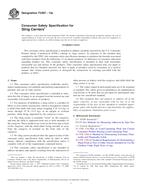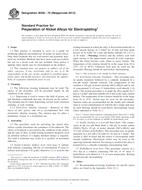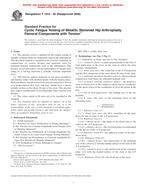1.1 This guide is Part Three of three guides to be used in conjunction with Practice D 5254 that delineates the data desirable to describe a ground-water data collection or sampling site. This guide identifies usage descriptors, such as monitoring, for an individual ground-water site. Guide D 5408 describes additional information beyond the minimum set of data elements that may be specified to identify a ground-water site, while Guide D 5409 identifies physical descriptors, such as construction, for a site.
Note 1 – A ground-water site is defined as any source, location, or sampling station capable of producing water or hydrologic data from a natural stratum from below the surface of the earth. A source or facility can include a well, spring or seep, and drain or tunnel (nearly horizontal in orientation). Other sources, such as excavations, driven devices, boreholes, ponds, lakes, and sinkholes, that can be shown to be hydraulically connected to the ground water, are appropriate for the use intended.
Note 2 – Guide D 5408 includes data confidence classification descriptor (1 element), geographic location descriptors (4 elements), political regime descriptor (1 element), source identifier descriptors (4 elements), legal descriptors (9 elements), owner descriptors (2 elements), site visit descriptors (3 elements), other identification descriptors (2 elements), other data descriptors (3 elements), and remarks descriptors (3 elements). Guide D 5409 includes individual site characteristics (7 data elements), construction descriptors (56 data elements), lift descriptors (16 data elements), geologic descriptors (26 data elements), hydraulic descriptors (20 data elements), and spring descriptors (11 data elements). For a list of descriptors in this guide, see Section 3.
1.2 These data elements are described in terms used by ground-water hydrologists. Standard references, such as Ref
Note 3 – The purpose of this guide is to suggest data elements that can be collected for ground-water sites. This does not uniquely imply a computer data base, but rather data elements for entry into any type of permanent file.
Note 4 – Component and code lists given with some of the data elements, for example” method of discharge measurement,” are only suggestions. These lists can be modified, expanded, or reduced for the purpose intended by the company or agency maintaining the ground-water data file.
Note 5 – Use of trade names in this guide is for identification purposes only and does not constitute endorsement by ASTM.
1.3 This guide includes the data elements desirable to document a ground-water site beyond those given in the minimum set of data elements. Some examples of the data elements are water level, discharge, and water-quality sample collection date. No single site will need every data element, for example, a monitoring site may not need a long-term water use record. Each record (group of data elements) for a site has mandatory data elements, such as the date for the water level record. However, these elements are considered necessary only when that specific record is gathered for the site.
1.4 The values stated in both inch-pound and SI units are to be regarded separately as the standard. The values given in parentheses are for information only.
This standard does not purport to address all of the safety problems, if any, associated with its use. It is the responsibility of the user of this standard to establish appropriate safety and health practices and determine the applicability of regulatory limitations prior to use.
1.5 This guide offers an organized collection of information or a series of options and does not recommend a specific course of action. This document cannot replace education or experience and should be used in conjunction with professional judgment. Not all aspects of this guide may be applicable in all circumstances. This ASTM standard is not intended to represent or replace the standard of care by which the adequacy of a given professional service must be judged, nor should this document be applied without consideration of a project’s many unique aspects. The word “Standard” in the title of this document means only that the document has been approved through the ASTM consensus process.
Product Details
- Published:
- 05/01/2007
- Number of Pages:
- 13
- File Size:
- 1 file , 140 KB


